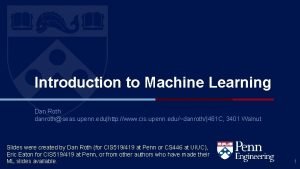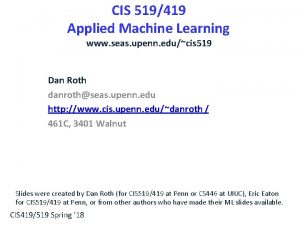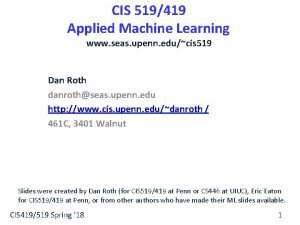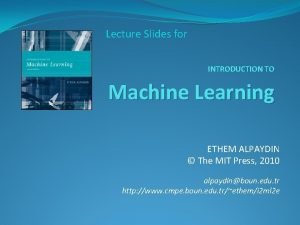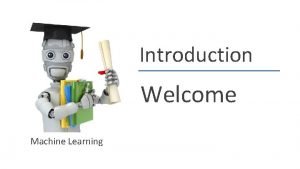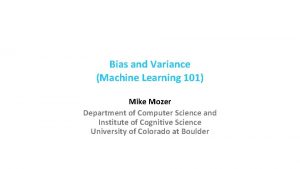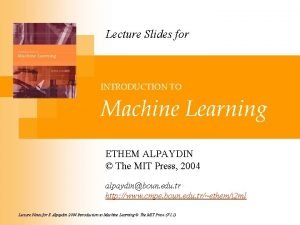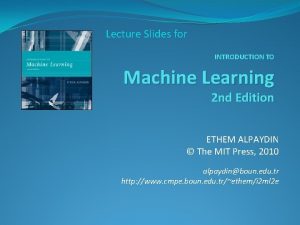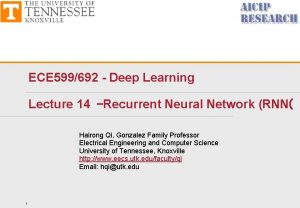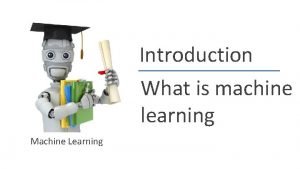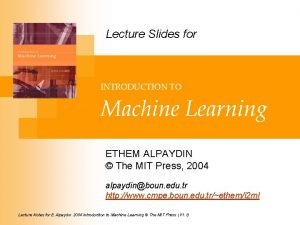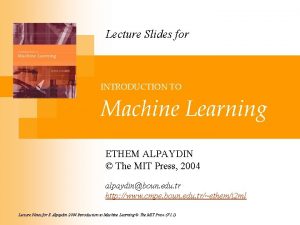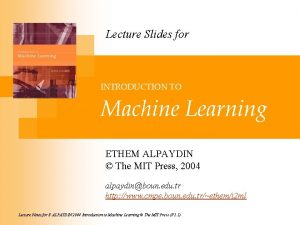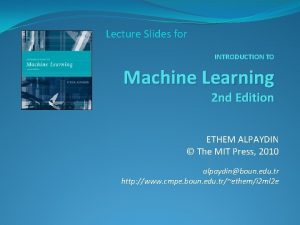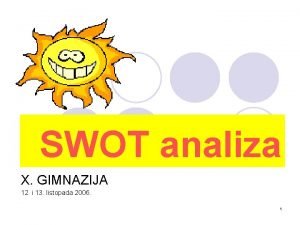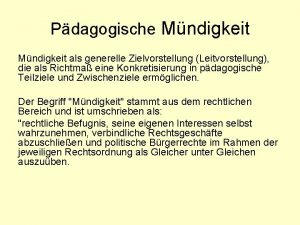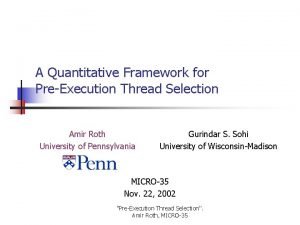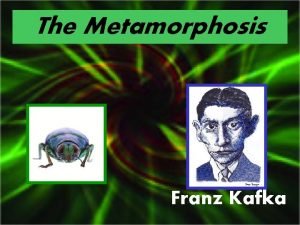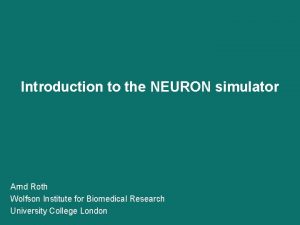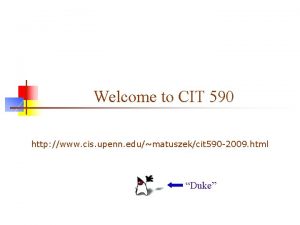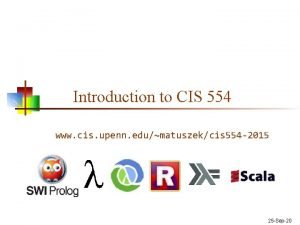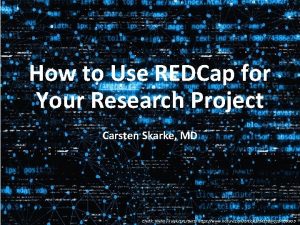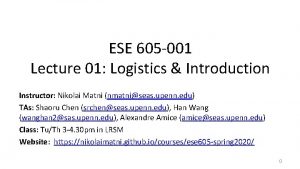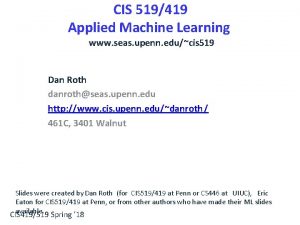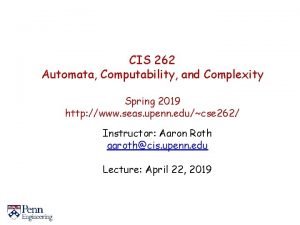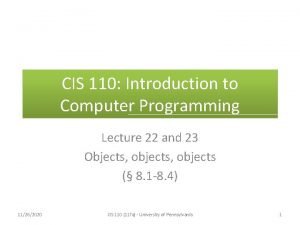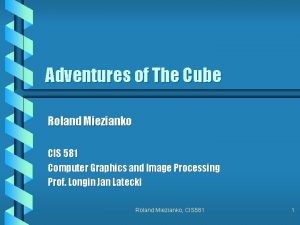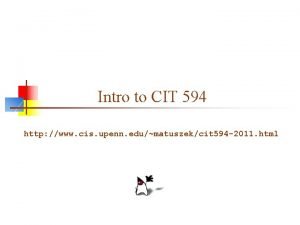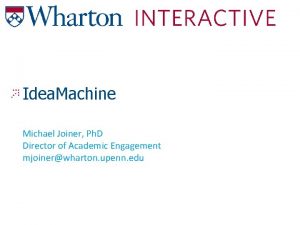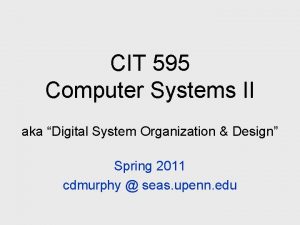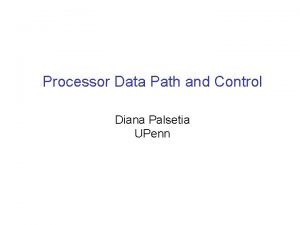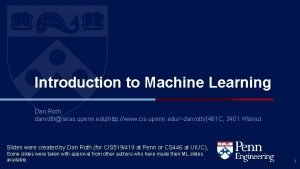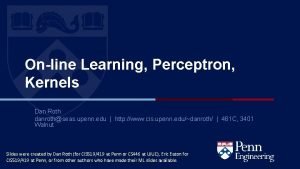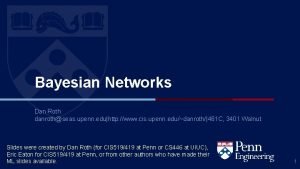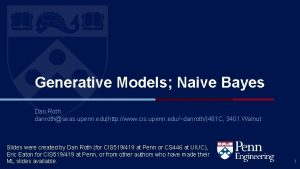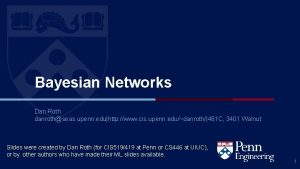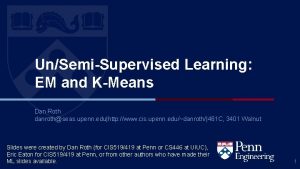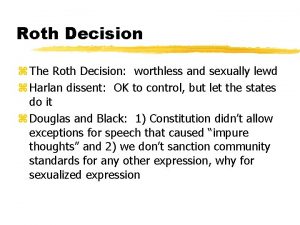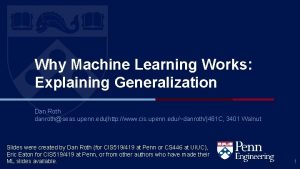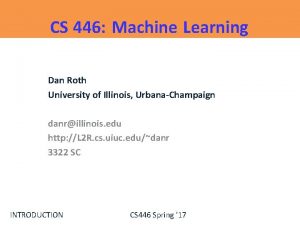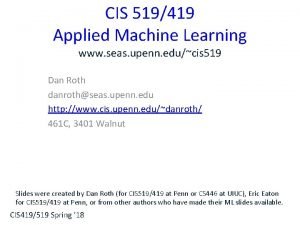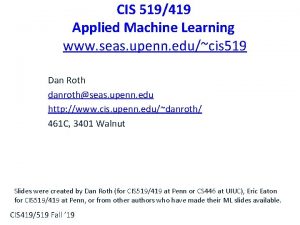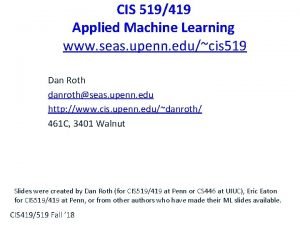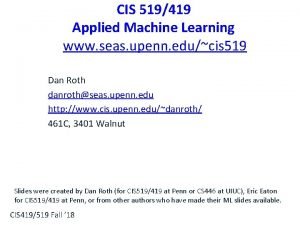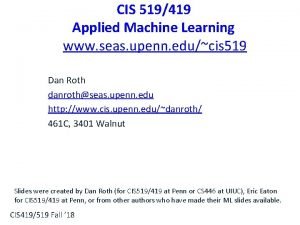Introduction to Machine Learning Dan Roth danrothseas upenn




















































![A General Framework for Learning • Simple loss function: # of mistakes […] is A General Framework for Learning • Simple loss function: # of mistakes […] is](https://slidetodoc.com/presentation_image_h/12517dd838aab3a67f3008a7bb3018e0/image-53.jpg)


















- Slides: 71

Introduction to Machine Learning Dan Roth danroth@seas. upenn. edu|http: //www. cis. upenn. edu/~danroth/|461 C, 3401 Walnut Slides were created by Dan Roth (for CIS 519/419 at Penn or CS 446 at UIUC), Eric Eaton for CIS 519/419 at Penn, or from other authors who have made their CIS 419/519 Fall’ 19 ML slides available. 1

Course Overview – Introduction: Basic problems and questions – A detailed example: Linear classifiers; key algorithmic idea – Two Basic Paradigms: » Discriminative Learning & Generative/Probabilistic Learning – Learning Protocols: » Supervised; Unsupervised; Semi-supervised – Algorithms » » » » Gradient Descent Decision Trees Linear Representations: (Perceptron; SVMs; Kernels) Neural Networks/Deep Learning Probabilistic Representations (naïve Bayes) Unsupervised /Semi supervised: EM Clustering; Dimensionality Reduction – Modeling; Evaluation; Real world challenges – Ethics CIS 419/519 Fall’ 19 2

CIS 419/519: Applied Machine Learning – – Monday, Wednesday: 10: 30 pm-12: 00 pm 101 Levine Office hours: Mon/Tue 5 -6 pm [my office] 10 TAs Assignments: 5 Problems set (Python Programming) • Weekly (light) on-line quizzes – – – Weekly Discussion Sessions Mid Term Exam [Project] (look at the schedule) Final No real textbook: HW 0 is mandatory Go to the web site Be on Piazza Registration for Class • Slides/Mitchell/Flach/Other Books/ Lecture notes /Literature CIS 419/519 Fall’ 19 3

CIS 519: What have you learned so far? • What do you need to know: Participate, Ask Questions – Some exposure to: • Theory of Computation • Probability Theory • Linear Algebra Ask during class, not after class § Applied Machine Learning § Applied: mostly in HW – Programming (Python) • Homework 0 § Machine learning: mostly in class, quizzes, exams – If you could not comfortably deal with 2/3 of this within a few hours, please take the prerequisites first; come back next semester/year. CIS 419/519 Fall’ 19 4

CIS 519: Policies – Cheating • No. • We take it very seriously. – Homework: Class’ Web Page Note also the Schedule Page and our Notes • Collaboration is encouraged • But, you have to write your own solution/code. – Late Policy: • You have a credit of 4 days; That’s it. – Grading: • Possible separate for grad/undergrads. • 40% - homework; 35%-final; 20%-midterm; 5% Quizzes • [Projects: 20%] A: 35 -40% ; B: 40% C: 20% – Questions? CIS 419/519 Fall’ 19 5

CIS 519 on the web • Check our class website: – Schedule, slides, videos, policies • http: //www. seas. upenn. edu/~cis 519/fall 2019/ – Sign up, participate in our Piazza forum: • Announcements and discussions • http: //piazza. com/upenn/fall 2019/cis 419519 – Check out our team • Office hours • [Optional] Discussion Sessions CIS 419/519 Fall’ 19 6

What is Learning? – The Badges Game… • This is an example of the key learning protocol: supervised learning – First question: Are you sure you got it? • Why? – Issues: • • • Prediction or Modeling? Representation Problem setting Background Knowledge When did learning take place? Algorithm CIS 419/519 Fall’ 19 7

CIS 519 Admin Registration for Class – Check our class website: • Schedule, slides, videos, policies – http: //www. seas. upenn. edu/~cis 519/fall 2018/ • Sign up, participate in our Piazza forum: – Announcements and discussions – http: //piazza. com/upenn/fall 2018/cis 419519 • Check out our team – Office hours We start today • Canvas: – Notes, homework and videos will be open. HW 0 is mandatory! • [Optional] Discussion Sessions: – Starting this week: Wednesday 4 pm, Thursday 5 pm: Python Tutorial – Check the website for the location CIS 419/519 Fall’ 19 8

What is Learning? • The Badges Game… – This is an example of the key learning protocol: supervised learning • First question: Are you sure you got it? – Why? CIS 419/519 Fall’ 19 9

Training data + Naoki Abe + Peter Bartlett - Myriam Abramson - Eric Baum + David W. Aha + Welton Becket + Kamal M. Ali - Shai Ben-David - Eric Allender + George Berg + Dana Angluin + Neil Berkman - Chidanand Apte + Malini Bhandaru + Minoru Asada + Bir Bhanu + Lars Asker + Reinhard Blasig + Javed Aslam - Avrim Blum + Jose L. Balcazar - Anselm Blumer - Cristina Baroglio + Justin Boyan CIS 419/519 Fall’ 19 + Carla E. Brodley + Nader Bshouty - Wray Buntine - Andrey Burago + Tom Bylander + Bill Byrne - Claire Cardie + John Case + Jason Catlett - Philip Chan - Zhixiang Chen - Chris Darken 10

The Badges game + Naoki Abe - Eric Baum • Conference attendees to the 1994 Machine Learning conference were given name badges labeled with + or −. • What function was used to assign these labels? CIS 419/519 Fall’ 19 11

Raw test data Shivani Agarwal Gerald F. De. Jong Chris Drummond Yolanda Gil Attilio Giordana Jiarong Hong CIS 419/519 Fall’ 19 J. R. Quinlan Priscilla Rasmussen Dan Roth Yoram Singer Lyle H. Ungar 12

Labeled test data ? Shivani Agarwal + Gerald F. De. Jong - Chris Drummond + Yolanda Gil - Attilio Giordana + Jiarong Hong CIS 419/519 Fall’ 19 - J. R. Quinlan - Priscilla Rasmussen + Dan Roth + Yoram Singer - Lyle H. Ungar 13

What is Learning – The Badges Game… • This is an example of the key learning protocol: supervised learning – First question: Are you sure you got it? • Why? – Issues: • Which problem was easier? – Prediction or Modeling? • Representation – Problem setting • Background Knowledge – When did learning take place? • Algorithm: can you write a program that takes this data as input and predicts the label for your name? CIS 419/519 Fall’ 19 14

Supervised Learning • CIS 419/519 Fall’ 19 15

Supervised Learning • CIS 419/519 Fall’ 19 16

Why use learning? • CIS 419/519 Fall’ 19 17

Supervised Learning CIS 419/519 Fall’ 19 18

Supervised learning: Training • Can you suggest other learning protocols? Learning Algorithm CIS 419/519 Fall’ 19 19

Supervised learning: Testing • Reserve some labeled data for testing CIS 419/519 Fall’ 19 20

Supervised learning: Testing CIS 419/519 Fall’ 19 21

Supervised learning: Testing Can you use the test data otherwise? • Apply the model to the raw test data • Evaluate by comparing predicted labels against the test labels CIS 419/519 Fall’ 19 22

Key Issues in Machine Learning – Modeling • How to formulate application problems as machine learning problems ? How to represent the data? • Learning Protocols (where is the data & labels coming from? ) – Representation • What functions should we learn (hypothesis spaces) ? • How to map raw input to an instance space? • Any rigorous way to find these? Any general approach? – Algorithms • • What are good algorithms? How do we define success? Generalization vs. over fitting The computational problem CIS 419/519 Fall’ 19 25

Using supervised learning – What is our instance space? • Gloss: What kind of features are we using? – What is our label space? • Gloss: What kind of learning task are we dealing with? – What is our hypothesis space? • Gloss: What kind of functions (models) are we learning? – What learning algorithm do we use? • Gloss: How do we learn the model from the labeled data? – What is our loss function/evaluation metric? • Gloss: How do we measure success? What drives learning? CIS 419/519 Fall’ 19 26

• CIS 419/519 Fall’ 19 27

• Does it add anything? CIS 419/519 Fall’ 19 28

– Possible features: • • Gender/age/country of the person? Length of their first or last name? Does the name contain letter ‘x’? How many vowels does their name contain? Is the n-th letter a vowel? Height; Shoe size CIS 419/519 Fall’ 19 29

• CIS 419/519 Fall’ 19 30

Good features are essential – The choice of features is crucial for how well a task can be learned. • In many application areas (language, vision, etc. ), a lot of work goes into designing suitable features. • This requires domain expertise. – Think about the badges game – what if you were focusing on visual features? – We can’t teach you what specific features to use for your task. • But we will touch on some general principles CIS 419/519 Fall’ 19 32

• CIS 419/519 Fall’ 19 33

Supervised learning tasks I • CIS 419/519 Fall’ 19 34

Supervised learning tasks II • CIS 419/519 Fall’ 19 35

We need to choose what kind of model we want to learn CIS 419/519 Fall’ 19 36

A Learning Problem Unknown function Example CIS 419/519 Fall’ 19 1 0 0 1 0 2 0 1 0 0 0 Can you learn this 0 function? What is it? 3 0 0 1 1 1 4 1 0 0 1 1 5 0 1 1 0 0 6 1 1 0 0 0 7 0 1 0 37

Hypothesis Space • CIS 419/519 Fall’ 19 Example 1 0 2 0 0 0 0 1 1 1 16 1 0 0 0 0 1 1 1 1 0 0 1 1 0 1 0 1 38 ? ? 0 1 0 0 0 ? ? 1 ? ? 0 ? ? ?

Hypothesis Space (2) • 1 0 0 2 0 1 0 0 0 Rule Counterexample 3 0 0 1 1 1 4 1 0 0 1 1 5 0 1 1 0 0 6 1 1 0 0 0 7 0 1 0 CIS 419/519 Fall’ 19 39

Don’t worry, this function is Hypothesis Space (3)actually a neural network… • variables Notation: 2 variables from the set on the left. Value: Index of the counterexample. 1 -of 2 -of 3 -of 4 -ofvariables 1 0 0 2 0 1 0 0 0 3 0 0 1 1 -of 2 -of 3 -of 4 1 0 0 1 1 5 0 1 1 0 0 6 1 1 0 0 0 7 0 1 0 Found a consistent hypothesis! CIS 419/519 Fall’ 19 40

Views of Learning • CIS 419/519 Fall’ 19 41

General strategies for Machine Learning – Develop flexible hypothesis spaces: • Decision trees, neural networks, nested collections. • Constraining the hypothesis space is done algorithmically – Develop representation languages for restricted classes of functions: • Serve to limit the expressivity of the target models • E. g. , Functional representation (n-of-m); Grammars; linear functions; stochastic models; • Get flexibility by augmenting the feature space – In either case: • Develop algorithms for finding a hypothesis in our hypothesis space, that fits the data • And hope that they will generalize well CIS 419/519 Fall’ 19 42

Key Issues in Machine Learning – Modeling • How to formulate application problems as machine learning problems ? How to represent the data? • Learning Protocols (where is the data & labels coming from? ) – Representation • What functions should we learn (hypothesis spaces) ? • How to map raw input to an instance space? • Any rigorous way to find these? Any general approach? – Algorithms • • What are good algorithms? How do we define success? Generalization Vs. over fitting The computational problem CIS 419/519 Fall’ 19 46

An Example: Context Sensitive Spelling • This is the Modeling Step What is the hypothesis space? Input/Instance space? Learning Protocol? Supervised? Unsupervised? CIS 419/519 Fall’ 19 47

Representation Step: What’s Good? • Learning problem: – Find a function that best separates the data • What function? • What’s best? • (How to find it? ) Ø Memorizing vs. Learning Ø Accuracy vs. Simplicity • A possibility: Define the learning problem to be: Ø How well will you do? – A (linear) function that best separates the data Ø CIS 419/519 Fall’ 19 On what? Impact on Generalization Ø 48

Expressivity • Probabilistic Classifiers as well CIS 419/519 Fall’ 19 49

Functions Can be Made Linear • Data points are not linearly separable in one dimension • Not separable if you insist on using a specific class of functions (e. g. , linear) CIS 419/519 Fall’ 19 50

Blown Up Feature Space • Ø Ø Key issue: Representation: Ø what features to use. Computationally, can be done implicitly (kernels) Ø Not always ideal. CIS 419/519 Fall’ 19 51

Exclusive-OR (XOR) • x 2 x 1 CIS 419/519 Fall’ 19 52

Functions Can be Made Linear Discrete Case • A real Weather/Whether example Whether Weather CIS 419/519 Fall’ 19 53

Representation (1) Feature Types: (what does the algorithm know about the input): 1, 2. relative position (+/-1) has this pos/w 3. Conjunctions of size two 4. word w occurs in (-2, +2) window around target Note: 4 feature types; many features The feature resulting from instantiating the type in the given data Some statistics (not part of the learning process; just for the understanding of the problem) CIS 419/519 Fall’ 19 54

Representation (2) Extracting features from the data: (what does the algorithm know about the input): 1, 2. relative position (+/- 1); pos/w 3. Conjunctions of size two 4. Occurrence of a word in a window around the target Note: 2 feature types; many features For each feature type, the data gives rise to multiple features; you don’t know which, before you see the data. CIS 419/519 Fall’ 19 55

Representation (3) Here the first index (0/1) is the label) Each example corresponds to one target occurrence; all the features for this target are collected into a vector, and the label is added. Here: - Sparse Representation of the feature vector. Why? - Variable size: Why? CIS 419/519 Fall’ 19 56

Administration – “Easy” Registration Period is over. • But there will be chances to petition and get in as people drop. • If you want to switch 419/519, talk with Nicholas Mancuso nmancuso@seas. upenn. edu – – You all need to complete HW 0! 2 nd quiz was due last night. HW 1 will be released on Wednesday this week. Questions? • Please ask/comment during class. – Change in my office hours: • Today: 3 -4 pm; Wednesday 1: 30 -2: 30 CIS 419/519 Fall’ 19 57

Third Step: How to Learn? – A possibility: Local search • • Start with a linear threshold function. See how well you are doing. Correct Repeat until you converge. – There are other ways that do not search directly in the hypotheses space • Directly compute the hypothesis CIS 419/519 Fall’ 19 58
![A General Framework for Learning Simple loss function of mistakes is A General Framework for Learning • Simple loss function: # of mistakes […] is](https://slidetodoc.com/presentation_image_h/12517dd838aab3a67f3008a7bb3018e0/image-53.jpg)
A General Framework for Learning • Simple loss function: # of mistakes […] is a indicator function CIS 419/519 Fall’ 19 59

A General Framework for Learning (II) • CIS 419/519 Fall’ 19 60

Algorithmic View of Learning: an Optimization Problem • A continuous convex loss function allows a simpler optimization algorithm. L f(x) –y CIS 419/519 Fall’ 19 61

Loss CIS 419/519 Fall’ 19 62

Example Putting it all together: A Learning Algorithm CIS 419/519 Fall’ 19

Third Step: How to Learn? – A possibility: Local search • • Start with a linear threshold function. See how well you are doing. Correct Repeat until you converge. – There are other ways that do not search directly in the hypotheses space • Directly compute the hypothesis CIS 419/519 Fall’ 19 64

Learning Linear Separators (LTU=Linear Threshold Unit) • w CIS 419/519 Fall’ 19 65

Canonical Representation • CIS 419/519 Fall’ 19 66

General Learning Principle • The loss Q: a function of x, w and y The Risk (Err) E: a function of w w CIS 419/519 Fall’ 19 t here is “time” or “iteration” # To find a local minimum of a function using gradient descent, we take steps proportional to the negative of the gradient of the function at the current point. 67

Gradient Descent • E(w) w To find a local minimum of a function using gradient descent, we take steps proportional to the negative of the gradient of the function at the current point. w 4 w 3 w 2 w 1 CIS 419/519 Fall’ 19 68

LMS: An Optimization Algorithm • w CIS 419/519 Fall’ 19 69

LMS: An Optimization Algorithm • CIS 419/519 Fall’ 19 70

Gradient Descent • CIS 419/519 Fall’ 19 71

Gradient Descent: LMS • CIS 419/519 Fall’ 19 72

Alg 1: Gradient Descent: LMS • CIS 419/519 Fall’ 19 73

Alg 2: Incremental (Stochastic) Gradient Descent: (LMS) Dropped the averaging operation. Instead of averaging the gradient of the loss over the complete training set, choose at random a sample (x, y) (or a subset of examples) and update wt • CIS 419/519 Fall’ 19 74

Learning Rates and Convergence • CIS 419/519 Fall’ 19 75

Computational Issues • CIS 419/519 Fall’ 19 76

Other Methods for LTUs • Fisher Linear Discriminant: – A direct computation method • Probabilistic methods (naïve Bayes): – Produces a stochastic classifier that can be viewed as a linear threshold unit. • Winnow/Perceptron – A multiplicative/additive update algorithm with some sparsity properties in the function space (a large number of irrelevant attributes) or features space (sparse examples) • Logistic Regression, SVM…many other algorithms CIS 419/519 Fall’ 19 77
 Dan roth upenn
Dan roth upenn Cis419
Cis419 Cis 419 upenn
Cis 419 upenn Nn roth
Nn roth Upenn machine learning
Upenn machine learning Concept learning task in machine learning
Concept learning task in machine learning Analytical learning in machine learning
Analytical learning in machine learning Pac learning model in machine learning
Pac learning model in machine learning Machine learning t mitchell
Machine learning t mitchell Inductive and analytical learning
Inductive and analytical learning Inductive and analytical learning
Inductive and analytical learning Instance based learning in machine learning
Instance based learning in machine learning Inductive learning machine learning
Inductive learning machine learning First order rule learning in machine learning
First order rule learning in machine learning Eager learner examples
Eager learner examples Deep learning vs machine learning
Deep learning vs machine learning Ethem alpaydin
Ethem alpaydin Machine learning andrew ng
Machine learning andrew ng Introduction to machine learning andrew ng
Introduction to machine learning andrew ng High bias low variance introduction to machine learning
High bias low variance introduction to machine learning Introduction to machine learning ethem alpaydin
Introduction to machine learning ethem alpaydin Machine learning course slides
Machine learning course slides Introduction to machine learning slides
Introduction to machine learning slides Introduction to azure ml
Introduction to azure ml Lstm lecture
Lstm lecture Machine learning definition andrew ng
Machine learning definition andrew ng Ethem alpaydin
Ethem alpaydin Introduction to machine learning ethem alpaydin
Introduction to machine learning ethem alpaydin Ethem alpaydin
Ethem alpaydin Machine learning lecture notes
Machine learning lecture notes Cuadro comparativo e-learning b-learning m-learning
Cuadro comparativo e-learning b-learning m-learning Primerica ira roth
Primerica ira roth Gerhard roth willensfreiheit ist eine illusion plato schema
Gerhard roth willensfreiheit ist eine illusion plato schema Marija roth psiholog
Marija roth psiholog Artikulationsschema grell
Artikulationsschema grell Eli, the fanatic summary
Eli, the fanatic summary Segno di tinel
Segno di tinel Pädagogische leitvorstellungen beispiele
Pädagogische leitvorstellungen beispiele Xkcd
Xkcd Tim roth heart of darkness
Tim roth heart of darkness Stefan roth rwth
Stefan roth rwth Amir roth
Amir roth The metamorphosis movie 1987
The metamorphosis movie 1987 Neuron yale tutorial
Neuron yale tutorial Backdoor roth ira conversion white coat investor
Backdoor roth ira conversion white coat investor John reece roth
John reece roth Zvi roth
Zvi roth Traditional ira hamilton
Traditional ira hamilton Dick roth
Dick roth Roth institut bremen
Roth institut bremen Marcie roth
Marcie roth Polyzentrischer ansatz
Polyzentrischer ansatz Roth robertson
Roth robertson Supervised learning dan unsupervised learning
Supervised learning dan unsupervised learning Supervised learning dan unsupervised learning
Supervised learning dan unsupervised learning Cit 590
Cit 590 Upenn mse in data science
Upenn mse in data science Upenn cis courses
Upenn cis courses Redcap upenn
Redcap upenn Hangfeng he upenn
Hangfeng he upenn Upenn.edu
Upenn.edu Ese605
Ese605 Upenn cis 519
Upenn cis 519 Cis 262 upenn
Cis 262 upenn Cis 110 upenn
Cis 110 upenn Cis 581 upenn
Cis 581 upenn Cit594
Cit594 Michael joiner upenn
Michael joiner upenn Cit595
Cit595 Hcm solution center upenn
Hcm solution center upenn Stew friedman
Stew friedman Decode
Decode

